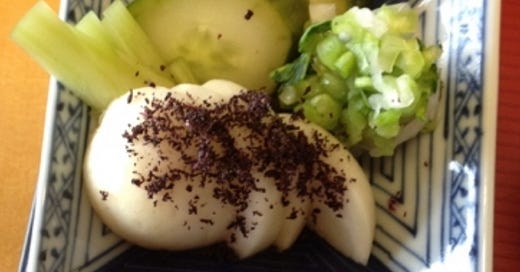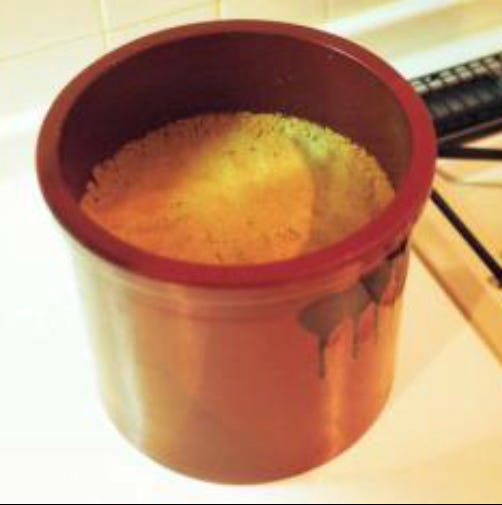Nuka World
What makes these rice bran fermented vegetables so tasty? A whole microbiome in your kitchen!
Hello fellow fermenting fiends!
Let’s talk about a fermentable that you won’t likely have heard about if you live in North America, or anywhere outside of Japan for that matter- nuka pickles or nukazuke.
Nukazuke (糠漬け) is regarded as a traditional Japanese fermented food and consists of vegetables with a salty, sour and umami flavour. Unlike what most people think of when they hear pickle (vinegary or salty liquid), nuka pickles are actually preserved in a semi-dry bed of fermenting rice bran. Since rice bran (the tough outer portion of whole rice) only became available to the Japanese when rice milling technology was introduced, nuka pickles are thought to have been invented some time in the 17th century. The rice bran bed or nukadoko is usually around 10-15% salt by weight and has chili flakes and seaweed added for spicy and umami flavour.
What I love about this form of fermentation is that a pickling pot made of wood or enamel is a staple of almost every Japanese home. Most of these vessels have been passed down from generation to generation and with them comes the same microbe-rich rice bran bed. In some instances, the same bed has been in use for at least 100 years, so in theory a nuka pickle made today could taste almost exactly the same as what an ancestor would have munched on! It really gives you a peak into the national identity of Japan and how they value family and fermentation. Nukazuke are enjoyed after dinner and thought to aid in digestion.
The other thing about nuka that is amazing is the speed of the fermentation. After a bed has been first inoculated with microbes (just with vegetable scraps from the kitchen) for 10-14 days and the bed is mixed by hand every day, a radish added to the nukadoko in the morning can be pickled by dinner (depending on age of the bed and ambient temperature). This is due to a unique microbiota that develops within the bed mainly consisting of Lactiplantibacillus (formerly Lactobacillus) species that come from the vegetables themselves.
To make your own:
Get a fermentation Vessel
Find high quality Rice bran
Measure out 100 g of kosher salt into 850 ml of water and bring to a boil. Let cool to room temperature or a tad bit warmer 75-78 degrees.
Add 850 g of rice bran into your vessel and add cooled salt water, mix with wooden spoon. Note that the mass and volumes can change depending on your size vessel, but follow the same ratio. 1:1 of rice bran to water and about 10% salt by weight.
Now at this point you can start adding vegetable scraps or you can add more flavour additives like chili flakes and dried seaweed. It depends on your taste, so you may have to experiment a few times to get something desirable to your family. Chili flakes are thought to add extra protection from food spoilage bacteria, but if you have good hygiene and allow the bed to develop as it should then it is not absolutely essential.
Almost any vegetable scraps will do, but leaves of raddish and cucumber skin seem to work well. Make sure the scraps are fairly large cut to make it easier to find in the pot. Make sure they are fully submerged in the nukadoko.
Cover your pot with a lid and keep in a warm part of the kitchen. Come back to the pot and hand stir it every day, make sure to move the top of the bed to the bottom, also take out the scraps and replenish with fresh ones. Take the scraps out and dust them off into the pot. Washing of your hands before mixing is important, the microbes in the bed should develop a salty and acidic environment that encourages lactic adic bacteria growth. No mold or rotten smells should develop. If they do, you need to start over and sterilize your vessel before trying again.
After 10-14 days off adding fresh scraps every day, the bed may be coming along depending on the temperature of your home. To test if it is ready, simply slice your vegetable of choice, lightly salt the outside and add to the pot fully embedded.
Wait anywhere from 8-24 h. The vegetable should become less firm and take on a sour taste. It should be noted that vegetables with less moisture content like raddish work best. Before eating, dust off the remaining bran into the pot and then wash vegetable with cold water.
After a month you may need to add some fresh rice bran to replenish the bed. Just note the bacteria are mainly coming from the vegetables that you put in the bed, so spring for organic or garden grown when you can.
The great thing about nuka is that we can take a peak into the microbial community of the bed and understand why the food is being persevered. A scientific article published in 2014 by Ono and his colleagues used genetic sequencing to observe how the microbial community changes over time in several fermentations. The authors noted that in all cases after two weeks of fermentation, the bacteria that was found in the highest abundance was Lactiplantibacillus plantarum. This species is represented by many strains that are clinically proven to provide health benefits including: reduction in blood pressure, improvement of insulin sensitivity and improved weight maintenance. It should also be noted that L. plantarum is the dominant species in other forms of fermented vegetables like kimchi and brined pickles found in North America. In the final analysis, a plethora of cultures have not only survived, but thrived due to the acidic environment that L. plantarum loves to create when it gets into contact with vegetables in a nice warm kitchen.
Disclaimer: The opinions expressed in my articles are my own and do not reflect those held by the authors or publishers of the articles discussed herein. I do not claim ownership of any of the data, or images presented.
hope you enjoyed reading and see you next time.
Any questions or comments? Send them my way!
tell your friends to subscribe!





